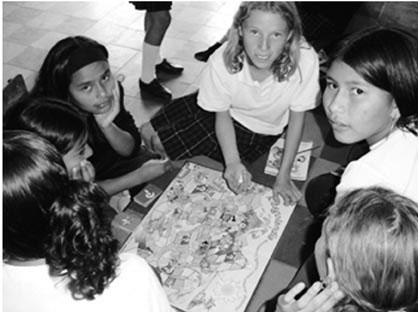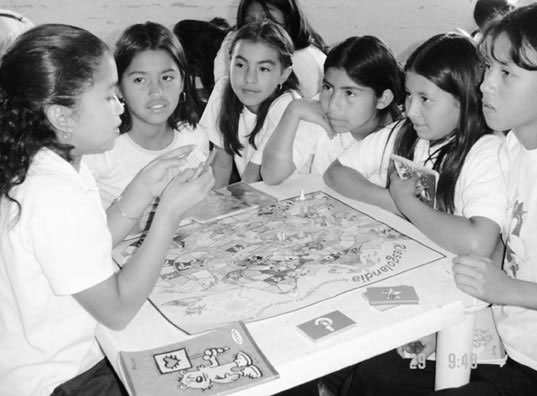|
Colombian children and youth learn how to prevent
disasters by playing Riskland
With the support material provided
by the ISDR, a research group at the University of Cauca, Colombia,
taught children and college students how to prevent disasters by
playing Riskland. The Research Group on Environmental Risk (GIRA)
was established in 2002 by initiative of a group of students of
the program entitled “Geography of Regional and Environmental
Development”, at the University of Cauca.
Due to the increasingly need to
consolidate academic and research programs for risk management,
the ISDR to request the education materials GIRA contacted, in order
to support the establishment of a Network of Schools for Disaster
Prevention and Preparedness (REDESPAD). This project has been implemented
during the last six months, and is aimed at strengthening education
for risk reduction and disaster response among children. The Julumito
school was chosen as the pilot education center for this project,
as it is located in the fringe area of the Municipality of Popayán,
an earthquake-prone city.
The documents provided to the GIRA group served as methodological
support material for risk management, and were used to raise awareness
among the educational community, and children in particular, of
issues that are new to them -such as disaster prevention- through
a number of innovative activities that are not usually found within
the Colombian educational context.
There was the need, then, to apply
new methodologies that go beyond what is written in a book. This
is why we implemented tools by which children may work using their
many learning styles to achieve a more perceptive result of their
environment.
The project is composed of ten phases,
of which seven have been finalized. During the first, stage the
booklet “Learning to Prevent Disasters” was used to
familiarize children with new concepts such as threat, vulnerability
and risk. As part of this introduction, recreational activities
that included these concepts were carried out to capture the children’s
attention.
Once these concepts were clear,
the second phase began by identifying which threats and hazards
put their community at risk. At this point, children were able to
identify, for example, hazards caused by factors related to the
public order, seismic activity, and floods, which are common in
this area and are a consequence of deforestation in the stream that
runs near their school.
During
the third phase, it was identified how vulnerable they are to these
phenomena, and participants expressed their inability to cope with
them due to the lack of knowledge about these issues, as well as
the lack of visibility of public bodies such as police officers,
fire fighters and civil defense officials.

During the fourth stage, after exchanging
opinions, students concluded that if vulnerability is added to hazards,
this will result in risk. They believe that it is important to be
organized as an educational institution so that risk does not become
a disaster.
After learning more about their
environment, the fifth stage began with games such as Riskland and
others included in the booklet. Students showed their learning aptitude
by answering a number of questions related to these issues. This
phase was one of the most fun and was a direct result of the previous
stages. The fifth stage encouraged them to think that human and
social development may be defined as a process for change based
upon education, which includes prevention and care.
The sixth and seventh stages included
the formulation of a school prevention and mitigation plan. Students
were the major actors that lead risk management, through which they
learned and shared experiences. Also, social maps were used as a
tool for children to identify, from their own homes, which places
are dangerous. These two stages are currently being developed.
As
part of the eight and ninth phases, a school emergency brigade is
expected to be established. The project is seeking help from the
Municipality to sponsor training for children in this field.

To complete the tenth stage, it
has been planned to prepare educational material related to the
school prevention plan and, hopefully, given the support of parents
and the community at large, a contingency plan for Julumito as well.
In conclusion, the material was
well accepted by students who expressed that this is the best way
to learn about their community and its problems, which had not been
taken into account before. Besides raising awareness, this project
has made students want to make a change to improve their own environmental
safety.
For
further information, please contact:
Claudia Lucia Castillo. clcastillo@unicauca.edu.co
University of Cauca
School of Human and Social Sciences
Department of Geography
Program of Geography for Regional and Environmental Development
|




